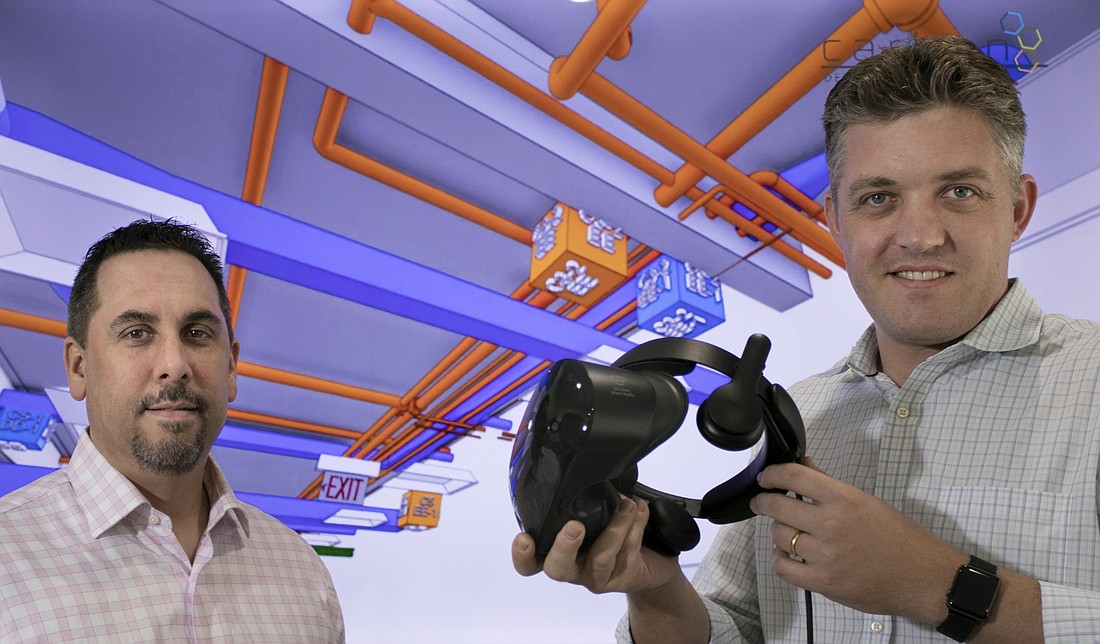- December 13, 2025
-
-
Loading

Loading

For both owners of newly built properties and the contractors who work for them, the dreaded punch list — work that doesn’t conform to project specifications — can lead to significant timeline and budget overruns, preventing the building from being ready to occupy.
Items on the list can be minor, like wall sockets, or major, like roof integrity. Regardless of magnitude, they represent mistakes and deviations that prevent an owner from opening a building on time and a contractor from receiving full payment.
Sean Williams and Jean-Frederic Monod, co-owners of Sarasota-based Carbon Design & Architecture, formerly known as Carlson Studio, are determined to make such mistakes a thing of the past. To get there they created Digital Punch, a virtual reality program that allows developers and builders to see and fix design flaws, even before ground is broken.
“Why not push it to the client to begin with?” Williams says. “Let them walk through their project at the very beginning, see exactly what they’re going to get and make sure there's no surprises and let them experience the same thing that we've experienced on the design side.”
“Nobody’s doing this at the design level. It’s a real-time rendering engine, and that’s important, because the feedback [to design changes] is instant.” Jean-Frederic Monod, co-owner of Carbon Design & Architecture
But big national builders like Suffolk already use VR technology to visualize both the exterior and interior of condo and office towers that have yet to be built. What makes the approach of Carbon, a tiny firm by comparison — Williams and Monod say they expect to close out 2019 with between $1 million and $1.5 million in gross revenue — so different, and how will the firm monetize Digital Punch?
The task begins with the duo’s long-established credibility as innovators in their field.
“We’ve trademarked the Digital Punch name as a process that we’ve found ourselves using more and more,” says Monod, 40. “We are the first owners that I know of who have been working in 3-D building information modeling (BIM) technology for well over 15 years.”
Before going into business with Monod, Williams, 42, was part of the Tampa office of HOK, a multinational architecture firm that designed the Dali Museum in downtown St. Petersburg. That was in 2006, when 3-D architectural design was in its infancy. Meanwhile, Monod worked for Parker Walter Group Inc., a Sarasota architecture firm, as well as Wannemacher Jensen in St. Petersburg.
Between the two of them, “We’ve run into every problem on the planet,” Monod says of their combined experience.
But more than a decade after the advent of 3D modeling, the duo say, the architecture, engineering and construction industry has failed to keep up with rapid advances in the way buildings can be conceived. 3D design tools like Revit and Autodesk abound, and many will even detect and point out problems with, say, wiring or ductwork. But Digital Punch represents “a much more visceral” approach, Monod says.
Equipped with a VR headset and controllers in each hand, a user can not only stroll around inside a fully immersive digital rendering. He or she can also see behind walls, underneath the floor, above the ceiling, even way down into the slab of the structure — all without leaving an office or worksite trailer. Natural lighting based on the time of day can also be adjusted, so viewers can see how color is affected.
“It allows you to literally punch out the building like you would in real life,” Monod says. “Nobody’s doing this at the design level. It’s a real-time rendering engine, and that’s important, because the feedback [to design changes] is instant. We can wander through at any given time.”
Digital Punch is included standard in all of Carbon’s design packages, but the firm plans to license the program in some shape or form. “We’re looking at a few different models for that,” William says.
That could prove tricky, because the platform is built from off-the-shelf commercial software products Monod — a self-described “tech super-user” — cobbled together. For now, the firm seems content to deploy Digital Punch as a feature that will set it apart from other firms, as it eyes doubling revenue to $3 million in 2020.
Monod and Williams have been demonstrating Digital Punch’s power at trade shows for builders and hoteliers, and they’re using it at a handful of active jobs, including a 2,300-square foot, net-zero energy house in Sarasota and a new rec center in South Bay, a town at the southern tip of Lake Okeechobee.
Digital Punch, Williams says, “does not solve all the problems” associated with turning architectural designs into reality, “but we’re getting the known unknowns out of the way.”